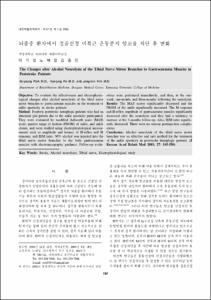KUMEL Repository
1. Journal Papers (연구논문)
1. School of Medicine (의과대학)
Dept. of Rehabilitation Medicine (재활의학)
뇌졸중 환자에서 경골신경 비복근 운동분지 알코올 차단 후 변화
- Keimyung Author(s)
- Park, Gi Young
- Department
- Dept. of Rehabilitation Medicine (재활의학)
- Journal Title
- 대한재활의학회지
- Issued Date
- 2003
- Volume
- 27
- Issue
- 4
- Abstract
- Objective: To evaluate the effectiveness and electrophysiological
changes after alcohol neurolysis of the tibial nerve
motor branches to gastrocnemius muscles on the treatment of
ankle spasticity in stroke patients.
Method: Fourteen poststroke hemiplegic patients who had an
abnormal gait pattern due to the ankle spasticity participated.
They were evaluated by modified Ashworth scale (MAS)
score, passive range of motion (PROM) of ankle, and ankle
clonus, and were studied using electrophysiological measurements
such as amplitude and latency of H-reflex and M
response, and H/M ratio. 50% alcohol was injected into the
tibial nerve motor branches to the both gastrocnemius
muscles with electromyography guidance. Follow-up evaluations
were performed immediately, and then, at the oneweek,
one-month, and three-months following the neurolysis.
Results: The MAS scores significantly decreased and the
PROM of the ankle significantly increased. The M response
and H-reflex amplitude of gastrocnemius muscles significantly
decreased after the neurolysis and they had a tendency to
increase at the 3-months follow-up. Also, H/M ratio significantly
decreased. There were no serious postinjection complications.
Conclusion: Alcohol neurolysis of the tibial nerve motor
branches was an effective and safe method for the treatment
of the ankle spasticity in poststroke hemiplegic patients.
- Alternative Title
- The Changes after Alcohol Neurolysis of the Tibial Nerve Motor Branches to Gastrocnemius Muscles in Poststroke Patients
- Keimyung Author(s)(Kor)
- 박기영
- Publisher
- School of Medicine
- Citation
- 박기영 et al. (2003). 뇌졸중 환자에서 경골신경 비복근 운동분지 알코올 차단 후 변화. 대한재활의학회지, 27(4), 545–550.
- Type
- Article
- ISSN
- 1225-584X
- Appears in Collections:
- 1. School of Medicine (의과대학) > Dept. of Rehabilitation Medicine (재활의학)
- 파일 목록
-
-
Download
 oak-bbb-3460.pdf
기타 데이터 / 334.71 kB / Adobe PDF
oak-bbb-3460.pdf
기타 데이터 / 334.71 kB / Adobe PDF
-
Items in Repository are protected by copyright, with all rights reserved, unless otherwise indicated.